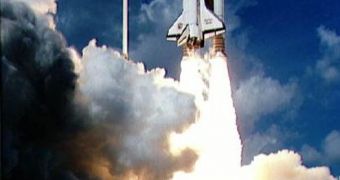On October 18, 1989, the Galileo Jupiter mission was launched aboard the space shuttle Atlantis from the Kennedy Space Center (KSC), in Cape Canaveral, Florida, during STS-34. It was scheduled to arrive in the gas giant's orbit on December 7, 1995, but it had to follow a very complex path through the solar system. The stage, known as VEEGA (Venus-Earth-Earth Gravity Assist), involved a number of planetary assist stages, which made planning the flight rather complex.
One of its biggest achievements was that it managed to observe debris from the comet Shoemaker-Levy 9 slamming into Jupiter. Additionally, Galileo represented the first groundbreaking scientific mission to an outer solar-system planet. It took a rather complex approach to flying among the planets, before it reached the gas giant. After being released from Atlantis' cargo bay, it started being propelled by the Inertial Upper Stage, a two-stage rocket motor. It took it next to Venus, on February 10, 1990, then, next, to the Earth twice, on December 8, 1990, and, again, on December 8, 1992.
On its way to Jupiter, Galileo recorded images of two large asteroids, Gaspra (the first image of an asteroid taken by a space probe), and Ida, a 15.2-kilometer-wide (9.4-mile-wide) space rock, orbited by the first discovered moon, the 1.6-kilometer-wide (1-mile-wide) Dactyl. In July 1994, the spacecraft observed the debris of the comet Shoemaker-Levy 9, after it impacted Jupiter. Upon reaching the planet's orbit in 1995, it immediately dropped a probe through the atmosphere. It descended at the unbelievable speed of about 47.6 kilometers per second (106,500 miles per hour), and provided the first in-situ measurements of the gas giant's clouds and winds.
In addition to the data collected from its drop probe, Galileo also ran extensive measurements and observations of Jupiter's largest moons, Ganymede, Callisto, Io and Europa. The spacecraft was the first to infer that, some 100 kilometers (62 miles) under the surface of Europa, a liquid ocean of saltwater might exist, two times larger than all the waters of the Earth combined. Further investigations showed that Ganymede and Callisto might also have saltwater somewhere under the surface.
On Sunday, September 21, 2003, the probe moved in the planet's shadows, and then disintegrated as it entered its atmosphere, at a speed of about 48.2 kilometers per second (nearly 108,000 miles per hour). Experts at the NASA Jet Propulsion Laboratory (JPL), in Pasadena, California, estimate that the speed was equivalent to traveling from New York to Los Angeles in about 82 seconds. “We haven't lost a spacecraft, we've gained a steppingstone into the future of space exploration,” Torrence Johnson, the project scientist for the spacecraft, said when the Galileo team received the probe's last signal.

 14 DAY TRIAL //
14 DAY TRIAL //